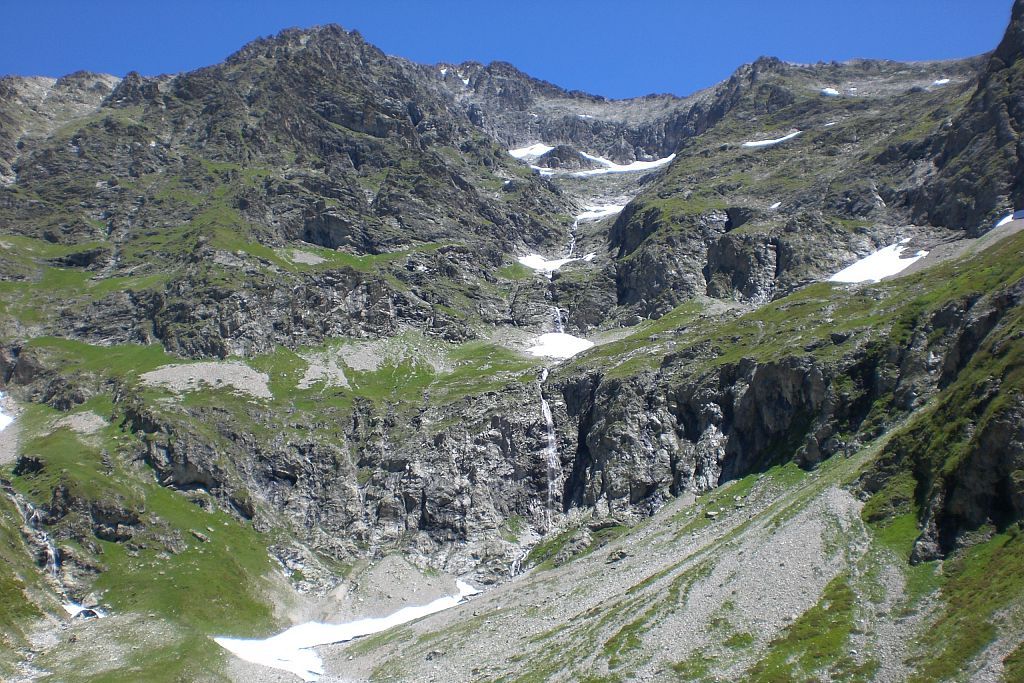
The Valsenestre valley
This trail winds its way through a large valley, inhabited by large number of chamois in the Alpine zone and by Alpine ibex in the mountain cliffs. The valley ends with a pleasant sloping ledge featuring a recently restored and authentic shepherd’s cabin.
Vincent Nobili; Valbonnais Park Keeper
Description
From the village of Valsenestre, after the stopover gîte, follow the path to the left. It heads due north through a few bends over fairly low-lying vegetation. From here, you can see the Béranger valley, before you arrive at a large plateau (Le Clos), where you cross the torrent over a small footbridge. From here on, in summer, you can see sheep grazing in the mountain pastures. Follow the valley along a winding path around a large rocky bar to arrive at the Valsenestre valley. Here there is a shepherd’s cabin where you can watch the chamois and Alpine ibex that are attracted by the salt lick put out for the sheep. Behind the cabin, you can see a waterfall that is the source for the stream.
The peaks surrounding this valley reach the high point of 3126 m at the Pic du Clapier du Peyron. To its left are the Brèche de Valsenestre 2,598 m, the Brèche du Lauvitel 2,855 m and lastly the Pas de l'Aiguille 2,354 m. To its right, the Col and the Tête de Ramu (2,760 m).
Take the same route on the way back.
- Departure : Valsenestre
- Towns crossed : Valjouffrey
11 points of interest
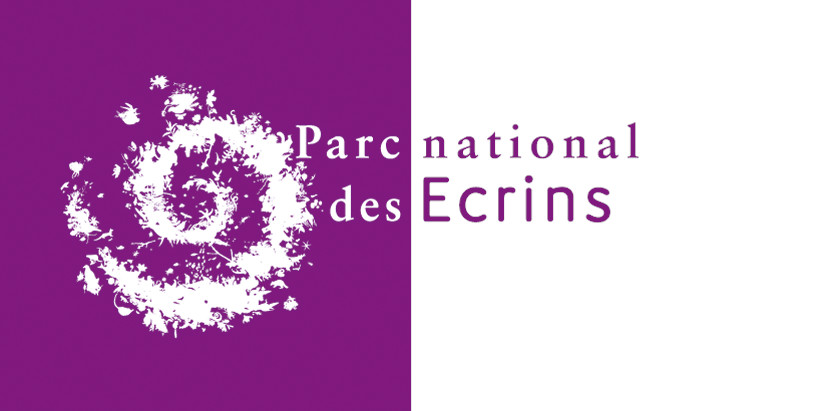
 Flora
FloraAlpine garden
More than fifty years ago, a botany lover, who is now elderly, created a small alpine garden in the centre of the village. Although it is less well kept nowadays, it still presents a stunning array of colour and a collection of spectacular plants belonging to alpine flora.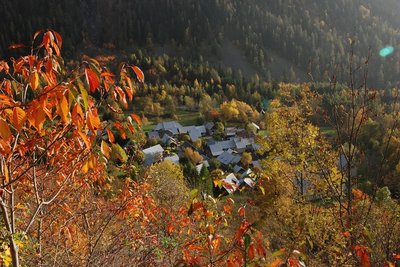
Valsenestre - Marion Digier - PNE  History
HistoryViewpoint over the hamlet of Vasenestre
In the 19th century, the hamlet of Valsenestre had roughly one hundred inhabitants. The main activity was breeding. In 1851, a marble quarry opened in the bottom of the valley on the way up to the Muzelle pass. This was an opportunity for the village. It welcomed the quarry workers and benefitted from an improved road. Marble production stopped in 1905. Up until 1926, children laughing and shouting could still be heard in the village. The school had about thirty pupils. It was closed a few years later and the last permanent inhabitant of the village left in 1948.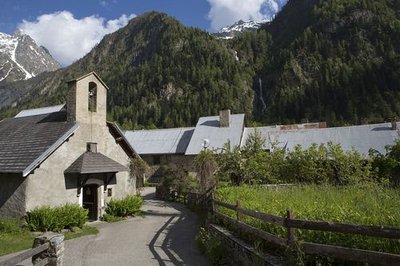
Le village de Valsenestre - Pascal Saulay - PNE  Architecture
ArchitectureRestored village
Valsenestre is a flower-filled village that has been superbly restored and is now made up of holiday homes The road is not cleared of snow in the winter. When the village had one hundred or so inhabitants it had a school (that has since been changed into a gîte d'étape (bed and breakfast halt), that closed in 1936. It was entirely buried by an avalanche in the 19th century. The main activity was still breeding but the opening of a marble quarry from 1840 brought complimentary resources to workers in the village. The last permanent inhabitant left Valsenestre in 1959.
 Pastoralism
PastoralismTerritory-specific and climate-related agri-environment measures
Under the French abbreviations MAET and MAEC, today there are European initiatives to support the most effective and ecologically sound management of agricultural and pastoral mountain areas. These agri-environmental measures are designed to encourage and remunerate volunteer users of mountain spaces in their actions to protect natural environments. These principles consist primarily in:
-avoiding over-grazing of alpine meadows,
-limiting the invasion of alpine meadows by shrubs and bushes,
-protecting the ground nesting sites of galliformes (white-tailed ptarmigan and black grouse),
-enriching the pastures by limiting the proliferation of non-palatable and invasive plants.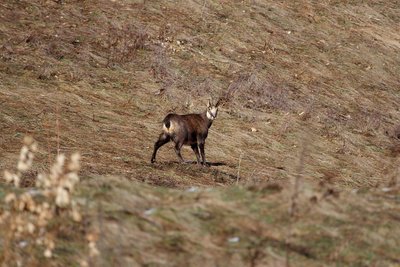
Chamois aux aguets - Christophe Albert - PNE  Fauna
FaunaThe chamois
The chamois is the iconic animal of the Alps. In fact, it is at home everywhere, in forest as well as rocky terrain. When the chamois feels disturbed, it emits a high-pitched whistle through its nostrils, a real alarm whistle. A population of chamois lives in this small valley and you can see herds of them in November during the rutting season. As the French poet and writer Samivel urged: « Declare peace on shy animals, do nothing to disturb their doings, so that your children still find delight in the springtimes ».
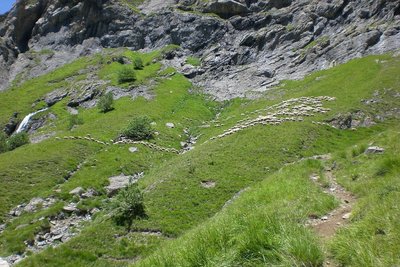
Le clos - Guidetti Georgette - PNE  Water
WaterLe Clos
Half-way along the trail route, you come to the locality called « Le Clos ». With a small mountain stream called Le Rif running though the middle of it, this intermediate valley makes this trail ideally suited to family walks. In fact, this stream is formed by the convergence of several other water courses flowing down from the surrounding heights. This abundance of water in the valley explains the abundance of plant life. Here, greens dominate... but maybe at dusk the eye of the experienced hiker will make out a beige smudge against this expanse of green: a chamois coming down to the water to drink.

Bouquetin Cerces - Christophe Albert - PNE  Fauna
FaunaThe alpine ibex
A ghost of the rocks, the ibex, also known as the steinbock, is stocky, plump and its coat is beige to chocolate depending on the season and its sex. The male's horns can read up to one metre in length, and curve backwards. In the summer, it can be spotted on the high slopes. It is also the torchbearer for nature protection. And so, having been reintroduced to the Valbonnais in 1989 and 1990, today the ibex visits this small valley in spring and summer.
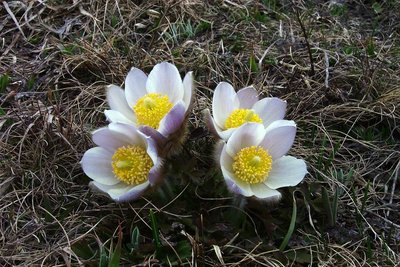
Pulsatilles printanières - Bernard Nicollet - PNE  Flora
FloraThe spring pasque flower
Bearing a single, golden-brown flower which opens in the spring, the magnificent spring pasque flower inhabits short grasslands and high-mountain heathlands. It therefore flowers early after the last snowmelt. Also nicknamed the « mouse anemone »due to the soft, silky hair on its white flower head, inside which there is a yellow gold-coloured centre. Standing just 6 centimetres tall, this little flower nevertheless knows how to make an impact with its tousled "hairdo", which it acquires when its seed head ripens.
Grande Fétuque - Bernard Nicollet - PNE  Flora
FloraThe great fescue or paniculated fescue
This is not a classic colourful flowering plant, but rather a grass that is conspicuous due to its size and density in some alpine pastures. A species that is so common it needs no description. Called the queyrel by the mountain sheep farmers, this is a grass with hard leaves making it unappetising to herbivores. A property which makes it highly invasive: strong roots and shoots developing in clumps from one rootstock (a growth habit known as "cespitose") it takes over where the meadows are no longer mown or grazed by the flocks.
Murets et reposoirs à proximité de la cabane - Bernard Nicollet - PNE  Vernacular heritage
Vernacular heritageLow walls and reposoirs
In the valley, close to the cabin, old low walls can be seen. These structures are called jas and were used by the shepherd to gather, separate and tend the sheep. There are few remaining signs of the age-old presence of these sheepfolds, other than the occasional marks and inscriptions etched into the rock walls, bearing testimony to their past existence. Enthusiasts are fascinated by them.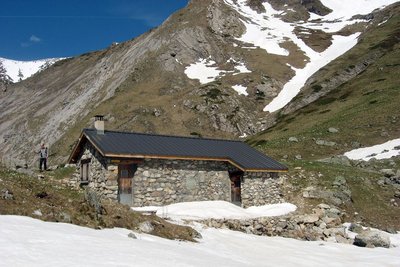
Cabane du Vallon de Valsenestre - Bertini Christian - PNE  Pastoralism
PastoralismThe Cabane du Vallon
Recently renovated, the Cabane du Vallon de Valsenestre is a high-mountain shelter used by shepherds in the summer months. It is built completely from stone and has a shower, a comfort appreciated by its occupant during the summer grazing period. A flock of sheep grazes this pasture from late June through to September. The shepherd staying in the cabin is accompanied by guard dogs, the famous Patou sheepdogs. In addition, there is another refuge further uphill. The Cabane du Valsenestre is also used as a temporary shelter when the shepherd wants to move higher up.
Altimetric profile
Sensitive areas
Golden eagle
- Impacted practices:
- Aerial, , Vertical
- Sensitivity periods:
- JanFebMarAprMayJunJulAug
- Contact:
- Parc National des Écrins
Julien Charron
julien.charron@ecrins-parcnational.fr
Recommandations
In winter, the access road to the car park is closed.
When you arrive at the cabin, you will see the flocks guarded by Pyrenean Mountain dogs, whose role is to defend the sheep. Don’t go too near them - although the dogs seem friendly, they might see you as a threat and become aggressive.
 In mountain pastures, protection dogs are there to protect the herds from predators (wolves, etc.).
In mountain pastures, protection dogs are there to protect the herds from predators (wolves, etc.).
When I hike I adapt my behavior by going around the herd and pausing for the dog to identify me.
Find out more about the actions to adopt with the article "Protection dogs: a context and actions to adopt".
Tell us about your meeting by answering this survey.
Information desks
Maison du Parc du Valbonnais
Place du Docteur Eyraud, 38740 Entraigues
Reception, information, temporary exhibition room, reading room and video-projection on demand. Shop: products and works of the Park. Free admission. All animations of the Park are free unless otherwise stated.
Transport
Bus from La Mure to Entraigues (Transisere - line 4120). Change at "Entraigues Place" for the local Valjouffrey service (local bus for 8 passengers) to Le Désert-en-Valjouffrey.
Access and parking
D 26 from La Mure
D 526 from Pont du Prêtre
D 117 from Entraigues to La Chapelle and Valsenestre
Parking :
Source

Report a problem or an error
If you have found an error on this page or if you have noticed any problems during your hike, please report them to us here:


